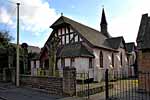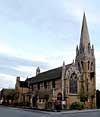For this church:    |
|
 The former mission
church, The former mission
church,now the church hall |
Meanwhile funds were being raised for a Mission Church to be built on Church Drive, it was dedicated in January 1890 with the Revd E M Vaughan as curate. It was a daughter church to Arnold St Mary and capable of sitting 270. The Bishop of Southwell gave a licence for Divine Service in the Mission Room for Daybrook and Sherwood, which was then in Carrington parish, and allowed the Revd William Sparks of Carrington to officiate as well as the Revd Mr Vaughan.
By 1891, the Sunday School was making good progress with 262 pupils and 17 teachers. An Institute was started in December 1890, opening four evenings per week and providing newspapers, games and, later, a library. Shortly after the new church opened in 1896 William Higginbottom, a local architect, converted the Mission Church into a sub-divided parish room, including a ladies room.
Col Charles Seely JP, who lived a few miles away at Sherwood Lodge, was committed to the new church right from the start. He was a wealthy colliery owner, High Sheriff of Nottinghamshire in 1890 and Vice-Chairman of the first Notts County Council established at that time. He gave £300 for running the Mission, having deposited £700 in October 1889 for the building of the permanent church. In late 1892 the main contributors to the Daybrook Church Endowment Fund were:
| Duke of Devonshire | £2,000 | |
| Col Charles Seely | £1,000 | |
| John Robinson | £500 | |
| Samuel Robinson | £250 | |
| Jas Snook | £100 | |
| Tom Potter | £100 | |
| Duke of St Albans | £100 | |
| Duke of Newcastle | £50 | |
| I & R Morley | £52 | |
| Others | £478 | |
| Total | £4630 |
John Robinson founded Home Brewery in Daybrook, his brother Samuel, the Daybrook Laundry. Tom Potter lived at Daybrook House and was the managing director of two local collieries. One of I & R Morley’s hosiery factories was in Daybrook.
In February 1892 Col Seely purchased the Advowson of Arnold from the Duke of Devonshire for £2000 in order to supplement the endowment of the New District of Daybrook. This was, in effect, the Duke of Devonshire’s only contribution. In return Col Seely wanted the Patronage of St Paul’s and the right to fix the pew rents of 200 out of 500 sittings. He was granted the Patronage in March but pew rents did not materialise.
The Mission Church Committee debated this matter for almost four years, beginning in February 1892. They agreed that at least half the seats were to be free but three years later they were still pondering whether the rest should be paid for but free at the stoppage of the bell, or free and appropriated entirely. They left the decision to Col Seely and in December 1895 he opted for the other half of seats to be free, although churchwardens were to nominate places for ‘regulars’. But three months later he had changed his mind and ruled that all seats be unappropriated.
This was yet another example of Col Seely’s generosity. He made three or four substantial donations to St Paul’s each year, and from 1902 onwards they were paid to the clergy. Special collections taken at the church for the General Hospital, Children’s Hospital and Nottingham and Nottinghamshire Convalescent Home reflected his dedication to those institutions. He and his wife also donated the pulpit, lectern and organ which were installed in the new church.
It was again due to Seely’s generosity that work began on the new building in June 1893. It was erected on 2648 square yards of land, at the corner of Mansfield Road and Church Drive, given by John Robinson the local brewer. He and others entered into a covenant to prevent the removal of any coal under the property within 100 yards of the piece of land ‘until a pillar of coal should be left to protect the said church’. The total cost of building St Paul’s was £26000.
The architect was John Loughborough Pearson, the designer of Truro Cathedral and St Augustine’s, Kilburn. According to Pevsner he built an all stone church, wide and large inside but not vaulted, in the Geometrical style. The builders were J W Woodsend. Although not complete – tower and bells were added later in 1896, the spire in 1897 – the church was consecrated on 4th February 1896 before almost 800 guests by the Bishop of Southwell, Dr. Ridding. On 18th September the Bishop of Derby dedicated the new font, pulpit and bells. The Ecclesiastical Commissioners’ architects, Caroë and Purday, approved the church in April 1896, describing it as ‘A substantial structure handsomely finished’.
The Revd Edward Marychurch Vaughan was nominated to the new Consolidated Chapelry of St Paul by Sir Charles Seely. Vaughan had been curate of the Church Mission for six years and had been conducting baptisms since 6th February 1890 (Marriages took place from 24th June 1896). He moved on to St Leodegarius, Basford in 1902 and was succeeded by the Revd Louis Herbert Wellesley Wesley whose ‘wisdom and holiness did much to consolidate a clear perception of Catholic truth’ (Jubilee Book 1946). He resigned in 1906, unable to carry on the work of a large parish without the help of his wife who had died in July 1905.
His successor the Revd John William Farrell was formerly at St John the Divine, Bulwell and at Christ Church, Cinderhill. In his time a Penny Bank and a Married Women’s Emergency Fund were started. Sir Charles Seely died in 1915, leaving the parish desperately short of funds. Farrell wrote twice to the Ecclesiastical Commissioners pleading for a grant to pay for a curate who previously had been paid, in effect, by Seely. He cited a population of 5000, many of them miners and many of them poor, and four places of worship ie St Paul’s, Sherwood Lodge Chapel, the Cedars Convalescent Hospital and Arnot Hill Hospital. Still they refused. Coupled with the workload imposed by the Great War the strain was too much and Mr Farrell died on 20th January 1919.
The Revd Rupert Browne-Wilkinson had spent the war years as a Chaplain in France. He continued to badger the Ecclesiastical Commissioners for a curate’s stipend and was finally rewarded in August 1921 when £60 was granted. By then a second curate was needed due to the population growth. He consolidated the work of the new Church of the Transfiguration in Sherwood. He was enthusiastic about the Tractarian Movement and introduced the 9.30 a.m. Parish Eucharist, to some criticism. One of his ‘devoted Priests’ in the parish was Philip Abraham who became the Bishop of Newfoundland.
According to the 1908 Terrier no parsonage existed although there was £1478 in the bank for one. The Vicar had been living in a house lent by the Patron Sir Charles Seely who, in July 1914, conveyed this plot of land and Cherry Hill House on Church Crescent to the Ecclesiastical Commissioners as the Parsonage. It was often said to be too large and inconvenient. Sir Charles gave £653 to provide for fences and upkeep but he died in 1915 and, by 1924, the Revd C G Everitt was living in temporary accommodation as the Parsonage was quite unsuitable due to the lack of repairs . It was sold off during the vacancy in the parish in 1962-64. The two-bedroom house offered in its place was refused by the Revd J W Busby who withdrew his acceptance of the incumbency. A larger house was then acquired on Oxclose Lane and the Revd Michael Hare-Duke lived there from April 1964 to 1969. Later he became the Bishop of St Andrew’s, Dunkeld and Dunblane.
The new parish of St Paul had to be created from St Mary’s Arnold and St John’s Carrington. The boundaries laid down in February 1896 were: part of Arnold bounded on the west by Bestwood Park and Basford; south west by the District of Carrington and partly by the New Parish of St Ann, Nottingham; south east by the New Parish of St Paul, Carlton-in-the-Willows and by Gedling; north east by a line from the junction of Plains Road and Gedling Road to Front Street, then Mansfield Road. Col Seely asked the Ecclesiastical Commissioners to extend the boundary north to include his home, Sherwood Lodge, about 3½ miles from St Paul’s. Although it would mean a parish of strange shape it would include only a few extra parishioners. He was, after all, the Patron and his wish was granted. The longest part of the parish was 6¾ miles. (Click here for a map of this parish.)
Further boundary changes were necessary as the population of Sherwood and Woodthorpe rose rapidly between the World Wars. The development of the Sherwood Estate in the early 1920’s put great pressure on the minister of St Paul’s. Thus a temporary church, the ‘Tin Tabernacle’, was erected behind The Cedars on Mansfield Road, prior to St Martin, Sherwood being opened in 1937.
In 1931 the population of Daybrook was 9,714 and was expected to rise to 20,000 by 1945. Another church was envisaged on Arno Vale Estate and a second-hand iron one was contemplated but never purchased. However, land was acquired between Wensley Road and Arno Vale Road for a district church, a ‘daughter’ of St Paul’s. This was never built as objections were raised by Arnold UDC (The land was used to build a church hall, later sold for the present Woodthorpe Library). In January 1939 the Bishop of Southwell decided a new parish should be formed with a new church and in 1940 part of St Paul’s parish was transferred to the District of St James, Porchester. The area involved was bounded by Gedling Road, Hickling’s Lane, Thackeray’s Lane, the Nottingham Suburban Railway, Woodthorpe Drive and Plains Road. The Second World War intervened and it was 1962 before St Mark’s, Woodthorpe was consecrated.
Daybrook has two church halls, one on Church Drive which was the original Mission Church and the other on Byron Street. A site for the latter was sold in 1959 to the Church for £5 by Home Brewery, which also donated £2500 towards the building of Cecil Hall, as it was known, which was also a Mission Church. It cost £5770 and opened in September 1959. It was demolished in October 1992 and replaced by St Timothy’s Church and Community Centre, also on Byron Street near to Oxclose Lane. It was officially opened and consecrated in June 1993. The estimated cost was £130,000.
In 1921 two-thirds of the working population in Daybrook was said to be in manufacturing and about one-third in mining. The main employers were Home Brewery, Daybrook Laundry, Jacoby & Co’s lace factory, I & R Morley’s hosiery factory, Daybrook Soap Works, the railways and coal mines (only the laundry remains in 2000). The miners lived in Daybrook but worked at Bestwood or Gedling Colliery. If anyone in the parish felt a spiritual need the choice was either St Paul’s or the Baptist Chapel in Daybrook Square. Methodist services were held briefly in the village in the 19th century but all the various Methodist Chapels were and are in the neighbouring town of Arnold. The first Daybrook Baptist Chapel was built in 1859 and replaced in 1912 with the present church and schoolroom. Until that date there was no baptistery so baptisms entailed an eight mile round walk to Broad Street Chapel in Nottingham. Until members of the latter took an interest in Daybrook in 1844 it had ‘been utterly neglected spiritually’.






